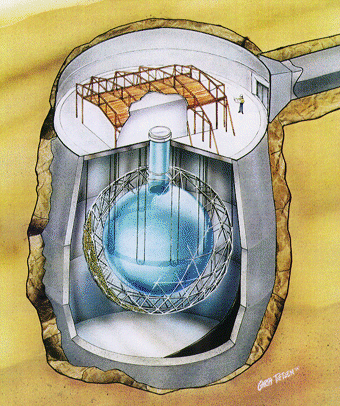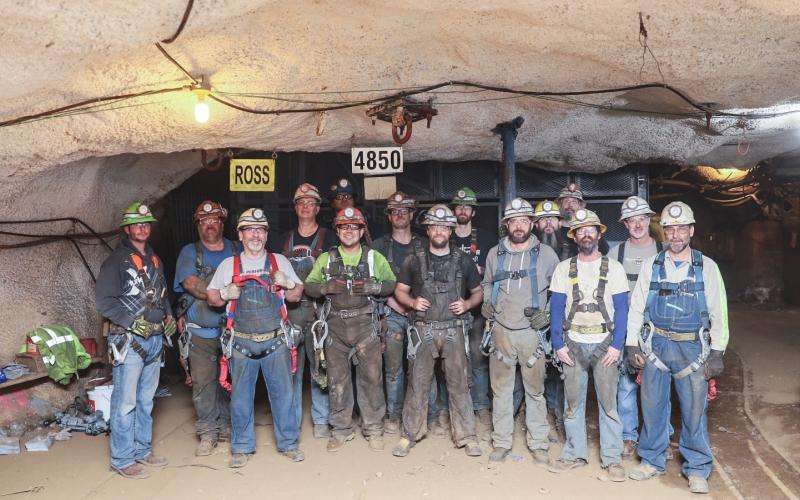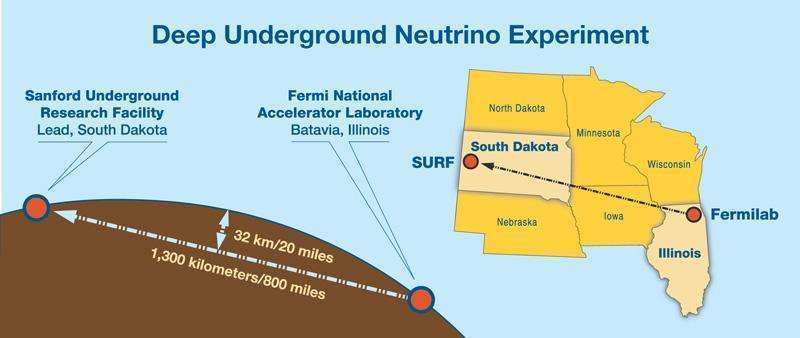Call Toll Free +1 855-856-TIPS

South Dakota – An underground facility approximately one mile below the surface of South Dakota will soon become the new laboratory where neutrinos will be studied. A neutrino is a subatomic particle which has no electrical charge and a small mass. They are one of the most abundant particles among the universe but due to their limited interaction with matter, they are extremely difficult to detect. Discerning neutrinos requires incredibly large and sensitive detectors.
In the Sudbury Neutrino Observatory in Ontario, Canada, a 1000-ton heavy water solar-neutrino detector is necessary to locate just 30 neutrinos per day. Neutrinos could serve as the new building block for technology since the particles are capable of speeding up global communication, pinpointing the presence of nuclear weapons, and confirming the existence of evasive dark matter.
The Long-Baseline Neutrino Facility will one day, within the next few years, host the international Deep Underground Neutrino Experiment. The study is funded by the U.S. Department of Energy’s Fermi National Accelerator Laboratory (LBNF/DUNE).
Over 1,000 scientists and engineers from over 30 countries will be involved in the investigation of neutrinos
DUNE currently has three objectives. The first scientific aim is to determine whether neutrinos are influential in the matter-antimatter asymmetry of the universe. The agency also intends to look for neutrinos which indicate the creation of a neutron star or a black hole. Lastly, DUNE hopes to search and find subatomic signs which could aid scientists in developing a theory that unities the four forces of nature: gravity, electromagnetism, the weak nuclear force, and the strong nuclear force.
Sergio Bertolucci, a DUNE co-spokesperson, stated in Fermilab News that the revolutionary caverns will permit researchers to:
“measure all the parameters of neutrino oscillations in the same place”
enabling the team to, “perform precision measurements of the mass ordering, of the matter-antimatter symmetry violation, and of the mixing angles”

The grotto will contain a particle beam, infrastructure, and space for the study. Neutrino detectors will be established in the cavern, at the Fermilab site, and 800 miles away at the Sanford Underground Research Facility in South Dakota. The rooms will be cold enough to maintain cryogenic equipment and a hall specifically designed to produce neutrinos will be constructed. A particle beam will deliver protons that create neutrinos.
The Proton Improvement Plan II, also known as PIP-II, will reside at Fermilab, powering the particle beam. PIP-II contains a 700-foot-long particle accelerator which expels a stream of protons to 84% of the speed of light. The two buildings where PIP-II will be utilized are almost completed. There, the machine will create the most intense neutrino beam in the world.

Preparation for the excavation site in South Dakota began back in 2019. Construction crews officially began clearing about 1,000 tons of rock per day in 2021. Project managers anticipate the excavation process and construction of the caverns to be complete and fully operational during 2024.
Currently, about 274,000 tons of rock have been abolished. For the project to be classified as completely excavated, a total 800,000 tons of rock needs to be removed.
The facility is anticipated to have a surface area size of about eight soccer fields. Two of the caverns thus far are 500 feet long, 65 feet wide, and 90 feet high. Inside these particular buildings, detector modules ranging from 200 feet in length will be situated there.
The modules hold 17,000 tons of ultrapure argon chilled at -184 degrees Celsius. Inside the third cavern which is 625 feet long, 65 feet wide, and 36 feet tall, cryogenic support systems, detector electronics, and data acquisition equipment will be held there.
Contractor Thyssen Mining Inc. is conducting the excavation process of the caverns by utilizing the drill-and-blast method. This procedure requires construction workers to drill a multitude of holes, load them with explosives, and remove and transport the blasted rock up to the surface. Above ground, the rock is then crushed, placed on a conveyor, and deposited into the Open Cut, a prior open mining pit. A mile underground in the cleared path, enormous drills then install 20-foot-long-bolts into the rock walls, serving as anchors.
Approximately 16,000 rock bolts will be stationed throughout the cavern to secure rock in case of possible fractures during the blasting process. Mechanical engineer, Josh Willhite, says that the drill-and-blast technique will be finished during the fall of 2023. Willhite began working on the early plans for the facility over a decade ago in 2010. By May 2024, the floors and walls of the caverns will be covered with concrete.
However, before the drill-and-blast method could even begin, the pre-excavation phase had to be done first. This step consisted of renovating the Ross Shaft, advancing the rock crushing system, and constructing a ¾ mile long conveyor system which would transfer crushed rock to the Open Cut. During this time, engineers drilled a collection of core samples in order to determine the geological characteristics of the rock.

While the excavation operation continues, other contractors are preparing to begin the infrastructure phase. Lighting, electrical equipment, ventilation, and piping are included in the building stage.

The DUNE particle detectors are being worked on as well. UK scientists have started mass production of large detector components for the detector module that will be in South Dakota. CERN, a European laboratory, will also collaborate with DUNE, testing vertical-drift detector components. Switzerland researchers have also built near-detector components which will be utilized in this study.



